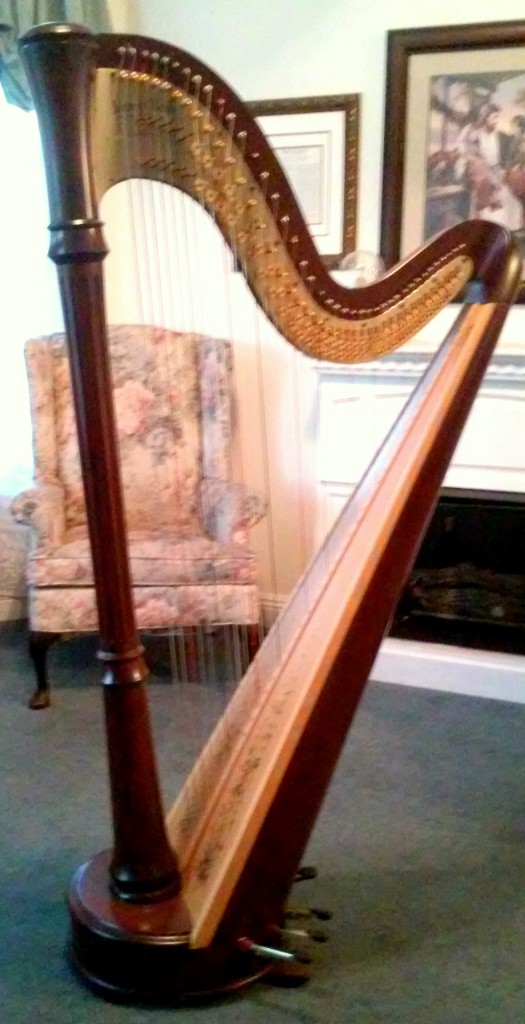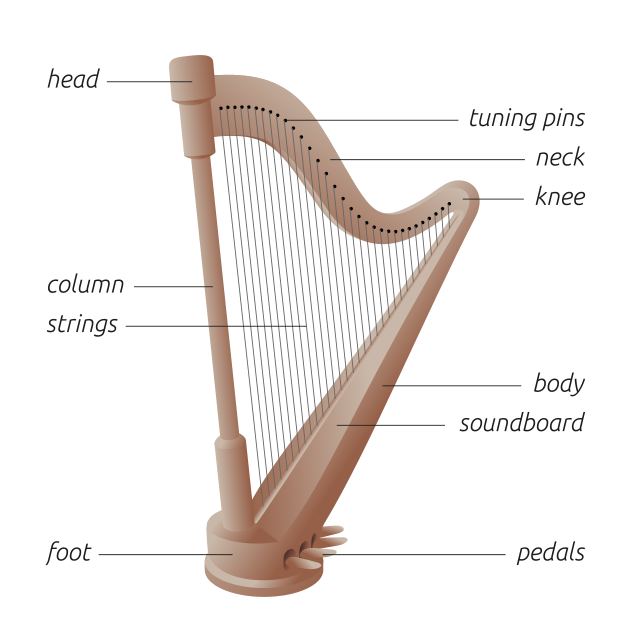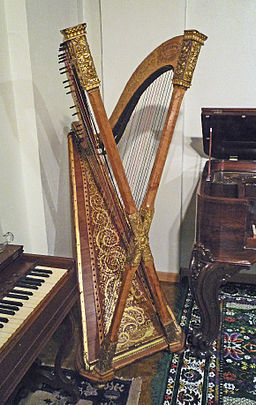by Donna Hatch
A reader recently made the astute observation that there is a harp, or at least mention of a harp, in most of the books and short stories I write. She guessed correctly when she asked if I play the harp.
 I do play the harp and have loved it since I was a child. Here is a picture of my harp, a Lyon & Healy 85 petite.
I do play the harp and have loved it since I was a child. Here is a picture of my harp, a Lyon & Healy 85 petite.
I fell in love with the harp at the age of 12–sort of a love at first mention. I can’t remember ever seeing a harp before that moment, at least not in person, nor do I remember ever noticing a one being played. But when I learned that a harp teacher was willing to teach harp lessons to children at my school for free, I knew in every cell of my body that I HAD to play the that magical-sounding instrument.
So began a love affair that has lasted all my life. I don’t play professionally anymore. I do teach, but mostly I play for pleasure and occasionally in church. It does something for my soul. Nighttime seems to be the time I play most often. It helps me wind down and quiets the noise in my head.
I began learning to play on a troubadour harp, which is a small, lever harp. Lever harps are perfect for children and beginners but many professional harpists chose to stay with a lever harp for a number of reasons–portability being one of the major reasons. I decided to go the classical route rather than sticking with more folk-style music, so I eventually ‘graduated’ to a pedal harp for each of playing accidentals and key changes, as well as having more octaves available.
Harps come in all shapes and sizes. Harpists choose their size and style depending on their’ preferences and budget. The full-size, concert grand harps you see in the symphony have a large soundboard that carries well enough to be heard in a concert hall. They also come with an equally large price tag. And you can even get them beautifully carved and/or gilded which adds to the aesthetic appeal and, of course, the cost.
My petite pedal harp provides the strings I need to play most folk and classic pieces without needed to make any modifications, and it’s more portable than a full concert grand. Since I seldom play outside of my own living room except for the occasional performance in church or Christmas parties, I don’t need a big, booming sound.
The big harps have not only larger sound boards to create a rich, resonate sound, as well as more volume, but they also have more strings–more octaves.
To change the string from natural to sharp or flat, the length of the string must be shortened or lengthened. On a lever harp, this is done by moving a lever for each string that needs to be moved. On a pedal harp, the harpist moves a pedal which changes that note in every octave.
 Here is an illustrated diagram of a harp. What the diagram calls the foot is also often called the base. The larger harps have taller columns, more strings in both directions, and a larger soundboard. The soundboard is what gives it the sound. Generally, the larger the soundboard and body (the curved part behind the soundboard), gives more richness of sound and more volume.
Here is an illustrated diagram of a harp. What the diagram calls the foot is also often called the base. The larger harps have taller columns, more strings in both directions, and a larger soundboard. The soundboard is what gives it the sound. Generally, the larger the soundboard and body (the curved part behind the soundboard), gives more richness of sound and more volume.
 Some harps have more than one set of strings. The harp pictured to the left is called a Double Chromatic Harp. I found this picture on Wikimedia Commons. I have never actually seen one like this in person nor heard it played. I can only assume that one hand goes on each set of strings the way other double harps are played. I tried to find a video on YouTube of someone playing a Double Chromatic Harp but couldn’t find one listed. I did find someone playing a regular double harp, which has two sets of strings side by side. I can see some distinct advantages to having two sets of strings, namely not having to so carefully time the repeated playing of a note.
Some harps have more than one set of strings. The harp pictured to the left is called a Double Chromatic Harp. I found this picture on Wikimedia Commons. I have never actually seen one like this in person nor heard it played. I can only assume that one hand goes on each set of strings the way other double harps are played. I tried to find a video on YouTube of someone playing a Double Chromatic Harp but couldn’t find one listed. I did find someone playing a regular double harp, which has two sets of strings side by side. I can see some distinct advantages to having two sets of strings, namely not having to so carefully time the repeated playing of a note.
This Sunday, I’m playing my harp in church accompanying the choir. Two flutes will also be performing. We’re doing “The King Love My Shepherd Is” arranged by Mack Wilberg.
Here is a video of the same arrangement performed by the Mormon Tabernacle Choir:
Do you play an instrument? If so, how has it influenced your life?

What an interesting post.